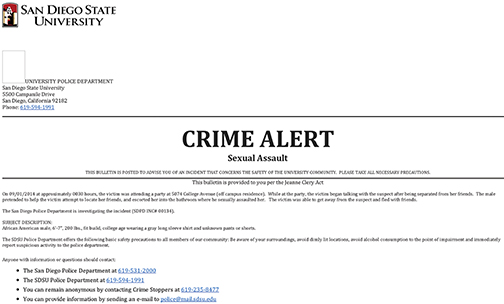I’m sure many students are as tired of reading about sexual harassment issues on campus as I am writing about them. I’ve practically become a beat reporter on the issue and after receiving the first crime alert about sexual harassment last weekend, I swore up and down I wouldn’t write about it.
Then it hit me: I keep writing about sexual harassment on campus because it’s still an overwhelming issue. It remains as such because this campus, even after a state audit for the inadequate handling of sexual assault reports, is still trying to protect its image by blanketing the issue with vague guidelines and less-than-thorough protocols.
The downpour of sexual-harassment related talk at San Diego State began last year when I covered the rising statistics of college students who are sexually harassed, tying it back into SDSU’s alarming report rates. After discovering 21 reported forcible sexual offense cases, which were never sent out in crime alerts by the SDSU Police Department, it begged one question: Why weren’t students notified of these alarming numbers?
As I began digging, I got the same textbook answers. As of last fall, SDSUPD officials clarified this question with the reasoning that it was crucial for both the victims and the suspects to have their identities kept private. This explanation made sense and was good enough at the time to feel that I had gotten the whole story.
Shortly after this discovery, SDSU received notice of a state audit for the way sexual assault cases were being handled—further confirming the suspicions I thought I had put to rest. Well after the completion of the audit, last weekend SDSUPD sent out the very first crime alert (in recent history at least) about a reported sexual assault incident. The location, incident details and suspect descriptions were all included. Where did the privacy guidelines go?
According to Cpt. Joshua Mays each report is judged on a case-by-case basis determining if it gets sent out in a crime alert. Coincidentally, the cases from the past two weekends met all the appropriate criteria shortly after the audit report got released.
“The police issue a crime alert when we determine there is a potential continuing or serious threat the community,” Mays said. “Each case is different and is evaluated on its own merits and circumstances. Obviously anything with the threat or use of violence is more concerning to everyone involved.”
Threat or use of violence? Personally, I have never heard of a sexual harassment case, yet alone 21 forcible ones, not involving threat or use of violence. Who actually believes out of all the cases reported to date, only one posed as threatening, violent and serious?
Do campus officials have the authority to determine one victim’s sexual harassment experience as non-violent and non-threatening? If so, it simply insinuates an unwarranted question of the victim’s credibility by allowing officials in charge to determine how severe the experience was.
In addition, ABC 10 News recently reported that in the last four years, 40 sexual assault reports have been made at SDSU, only two of which have led to arrests.
That’s justice for approximately 5 percent of victims who were brave enough to make a report. Not only is that an injustice for the outweighing majority, but it’s an injustice for an entire student body who could have used these reports to take precautionary actions.
The sole blame cannot be placed on SDSUPD, because although I’m unaware of the politics, I’m sure there are more people involved in the decision-making process. But the truth remains: SDSU has an image to protect and if its police department is passing out sexual harassment crime alerts like candy on Halloween, it’s going to create a larger problem — similar to the audit.
Unfortunately, this begs the question if school officials were protecting the victims or themselves by not sending out crime alerts in the past. No college campus wants to be known for a sexual assault problem, so in turn, vague reporting guidelines have been put in place, which thinly veil as protective measures for victims.
During these reporting incidents, many don’t consider the courage it takes for victims to report sexual assault. According to the Rape Abuse and Incest National Network, 60 percent cases are often left unreported. What message is being conveyed when only 5 percent of reports made in the past four years at SDSU have been resolved?
So, I’d like to take a moment to apologize to the minority brave enough to report such these incidents with hopes of getting some sort of justice. I’d like to apologize that a crime alert about a stolen iPhone took precedent over ones of sexual assault reports. I’d like to apologize that violations of personal privacy and safety didn’t fall under the criteria of violent or threatening.
So, I did consider turning the other cheek with yet another sexual harassment article, but it’s important for this campus to realize all sexual harassment cases are violent and threatening because they are unwarranted and unwelcome. In regards to the audit, it isn’t that SDSU officials don’t know how to report adequately, they simply know how to file them away even better.












